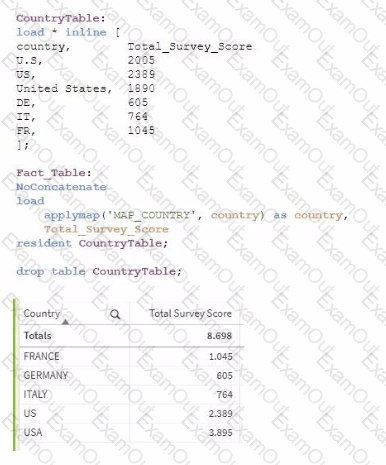A data architect needs to retrieve data from a REST API. The data architect needs to loop over a series of items that are being read using the REST connection.
What should the data architect do?

Refer to the exhibits.
On executing a load script of an app, the country field needs to be normalized. The developer uses a mapping table to address the issue. The script runs successfully but the resulting table is not correct.
What should the data architect do?

Refer to the exhibit.
A data architect needs to create a data model for a new app. Users must be able to see:
• Total sales for each customer
• Total sales for a given state
• Customers that have not had any sales
• Names of salesperson and regional account managers
• Total number of sales by date
Which steps should the data architect perform to meet these requirements?
Which steps should the data architect perform to meet these requirements?
Exhibit.

Refer to the exhibit.
A data architect is working on a Qlik Sense app the business has created to analyze the company orders and shipments.
To understand the table structure, the business has given the following summary:
• Every order creates a unique orderlD and an order date in the Orders table
• An order can contain one or more order lines one for each product ID in the order details table
• Products In the order are shipped (shipment date) as soon as they are ready and can be shipped separately
• The dates need to be analyzed separately by Year, Month, and Quarter
The data architect realizes the data model has issues that must be fixed. Which steps should the data architect perform?
The data architect has been tasked with building a sales reporting application.
• Part way through the year, the company realigned the sales territories
• Sales reps need to track both their overall performance, and their performance in their current territory
• Regional managers need to track performance for their region based on the date of the sale transaction
• There is a data table from HR that contains the Sales Rep ID, the manager, the region, and the start and end dates for that assignment
• Sales transactions have the salesperson in them, but not the manager or region.
What is the first step the data architect should take to build this data model to accurately reflect performance?

